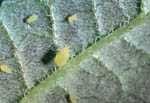Life History
The buckthorn aphid overwinters as an egg on buckthorn. In the spring, the buckthorn aphid migrates from the overwintering host, first to colonize weeds and by mid-July to potato crops. Late in the summer, winged males and females appear and migrate to buckthorn. The winged females give birth to wingless sexual forms which mate and lay the overwintering eggs.
Crop Injury
The buckthorn aphid infests the lower leaves of potato. It rarely increases in numbers sufficiently to weaken a crop or reduce potato yields. Summer populations are usually localized but, in those fields, this may be the most abundant species of aphid and, in a dry year, it can spread throughout the field.
The buckthorn aphid is an effective vector of potato virus Y.
Pest Management
Monitoring - Abundance of the buckthorn aphid is estimated by counting the numbers of aphids on leaves. In Eastern Canada, it is rarely economical to control this aphid only to prevent direct damage to the plants. For this reason, the empirical threshold is set very high. In New Brunswick, for example, the action threshold is 150 aphids per 3 compound leaves per plant and 80% of the plants infested.
Cultural Practices - Eradicating buckthorn shrubs from areas where potato is grown has been suggested, but the impact of this practice has yet to be evaluated.
Chemical Control - Any recommended insecticide should be applied whenever sudden, rapid and significant increases in buckthorn aphid populations occur. The buckthorn aphid is susceptible to a wider range of insecticides than other potato-colonizing aphids. However, because of its preference for the undersides of lower leaves, it may be more difficult to control. Nevertheless, chemical insecticides are the only available means for control of the buckthorn aphid when populations are sufficiently dense to endanger yields or to increase the spread of virus disease.

